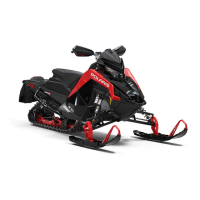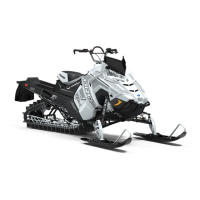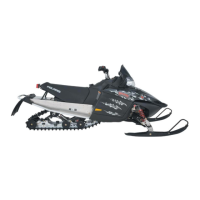What to do if my Polaris 850 MATRYX SWITCHBACK ASSAULT 146 2021 spark plugs are damaged?
- JJoe CrawfordAug 19, 2025
If you find that the spark plugs are either fouled or damaged, you should replace them.
What to do if my Polaris 850 MATRYX SWITCHBACK ASSAULT 146 2021 spark plugs are damaged?
If you find that the spark plugs are either fouled or damaged, you should replace them.
Why Polaris 850 MATRYX SWITCHBACK ASSAULT 146 2021 Snowmobiles won't start because of ignition switch?
Make sure the key is in the ON / RUN position. You can also test the switch using continuity test tables in the Electrical Chapter.
Why Polaris 850 MATRYX SWITCHBACK ASSAULT 146 2021 won't start because of auxiliary shut off switch?
Check that the auxiliary shut off switch is pulled up. You can also test the switch using continuity test tables in the Electrical Chapter.
How to test spark plug function on Polaris 850 MATRYX SWITCHBACK ASSAULT 146 2021?
Use a commercially available spark plug tester set at the specified electrode gap.
How to inspect stator on Polaris Snowmobiles?
Test the stator coil resistance, referencing the Electrical Chapter for resistance specifications. Also, inspect the 2 and 5 tooth position sensors.
What type of spark plug do I need for Polaris 850 MATRYX SWITCHBACK ASSAULT 146 2021 Snowmobiles?
Verify the specified spark plugs are installed and gapped to specification. Use NGK BPR9ES spark plugs with a gap of .27 in (.70 mm).
How to check fuel quality in Polaris 850 MATRYX SWITCHBACK ASSAULT 146 2021?
To check the fuel quality in your snowmobile, inspect the fuel in the fuel tank. Use a commercially available fuel tester to verify the ethanol content is 10% or less.
What to do if Polaris Snowmobiles fuel pump is not getting power?
To troubleshoot fuel pump power issues: 1. Connect a fully-charged 12V battery to the fuel pump prime connector. The fuel pump should turn on. 2. Connect Digital Wrench to the vehicle. 3. Use Output state control to test the fuel pump function. The ECU must command the fuel pump to turn on when using Output State Control testing.
What to do if my Polaris 850 MATRYX SWITCHBACK ASSAULT 146 2021 Snowmobiles is low on fuel?
Refill the fuel tank with fresh fuel. Note that the fuel pump may require priming or the fuel system may need to be purged of air if the snowmobile has run out of fuel.
How to check cylinder compression on Polaris Snowmobiles?
Test both cylinders under the same conditions using the same compression tester. Ensure the compression difference between the cylinders is 15% or less.
| Brand | Polaris |
|---|---|
| Model | 850 MATRYX SWITCHBACK ASSAULT 146 2021 |
| Category | Snowmobiles |
| Language | English |
Clutch settings for 650 and 850 models based on altitude, including drive, driven, and chaincase specifications.
Essential precautions for performing service work safely and correctly, including torque and fastener handling.
List of diagnostic trouble codes (DTCs) for MATRYX models, including SPN, FMI, P-Code, and condition.
Guide for troubleshooting engine starting issues, covering fuel system, switches, and engine mechanical/electrical components.
Steps for documenting and troubleshooting performance concerns, including checking clutches and suspension.
Overview of Digital Wrench software capabilities, including tests and diagnostic procedures.
Menu for ECU, fuel injector, and oil pump replacement procedures using Digital Wrench.
Procedure for reprogramming the ECU fuel and ignition map using Digital Wrench.
Diagnostic procedures for the PVT system, including drive belt, drive clutch, and driven clutch.
Troubleshooting guide for belt wear and burn issues, covering possible causes and solutions.
Notes on diagnosing electrical problems, including static and dynamic testing methods.
Procedure for testing circuits for shorts to ground and identifying potential causes.
Procedure for testing circuits for shorts to voltage and identifying potential causes.
Diagnosing intermittent electrical failures, often related to poor connections.
Procedure for measuring voltage drop in a circuit to understand resistance variations.
Items to inspect before each ride, covering drive/driven clutch, engine, brake system, and electrical system.
Maintenance intervals based on vehicle miles for various components.
Procedures for engine maintenance, including throttle lever freeplay inspection and adjustment.
Inspection and replacement of spark plugs as outlined in the periodic maintenance table.
Overview of the cooling system, coolant bottle level check, and system bleeding procedures.
Procedure for bleeding the cooling system, which is self-bleeding.
Procedures for drive belt removal and installation, and clutch maintenance.
Maintenance procedures for the fuel system, air intake, and exhaust system.
Warnings and recommendations for servicing the fuel system.
Maintenance procedures for the drive system, including drive chain tension adjustment and chaincase oil.
Procedures for changing chaincase oil using pump or cover drain methods.
Inspection of brake system components, including lever travel, feel, and caliper/pad components.
Maintenance for controls and handlebar components, including fastener torque.
Weekly inspection of front suspension components for damage and loose fasteners.
Inspection of PRO-CC rear suspension components for damage and loose fasteners.
Inspection of IGX 146 rear suspension components for damage and loose fasteners.
Maintenance procedures for the battery and other electrical components.
Notes on resetting the oil pump enrichment mode timer after specific engine service actions.
Testing and replacement procedures for oil injector check valves.
Testing and replacement procedures for the cross shaft oil gallery outlet check valve.
Procedure for testing the cross shaft oil gallery outlet check valve.
Procedures for replacing the cross shaft oil gallery outlet check valve.
Step-by-step instructions for removing the oil tank.
Step-by-step instructions for installing the oil tank.
Procedures for engine removal and installation.
Step-by-step instructions for removing the engine from the chassis.
Step-by-step instructions for installing the engine into the chassis.
General information, model number matrix, and engine specifications for 650 and 850 engines.
Fastener torque sequences for various engine components.
Inspection, disassembly, and installation procedures for the reed valve assembly.
Procedure for inspecting reed valve operation and air gap.
Step-by-step instructions for removing reed petals using specialized tools.
Step-by-step instructions for installing new reed petals with proper orientation.
Procedures for disassembly and inspection of top-end engine components.
Step-by-step instructions for removing the cylinder head.
Procedure for inspecting the cylinder head for warping using a straight edge and feeler gauge.
Step-by-step instructions for removing the cylinder.
Procedure for inspecting cylinder walls for wear and damage.
Procedure for honing the cylinder bore to remove glaze and create a crosshatch pattern.
Step-by-step instructions for removing the piston and piston circlips.
Measurement and importance of checking piston ring installed gap.
Procedures for disassembly and inspection of bottom-end engine components.
Step-by-step instructions for disassembling the crankcase halves.
Procedure for removing the crankshaft from the crankcase.
Procedure for measuring connecting rod side clearance and checking for rough spots.
Inspection of main bearings for discoloration, scoring, or galling.
Procedure for rebuilding and straightening a crankshaft for optimal run-out.
Procedure for measuring crankshaft runout and comparing to specification limits.
Procedures for water pump removal, installation, and seal replacement.
Step-by-step instructions for removing the water pump assembly.
Step-by-step instructions for installing the water pump assembly.
Information on electronic oil pump mounting, flow offset identification, and line connections.
Procedure to purge engine oil supply lines of air and verify ECU drives the oil pump.
Procedure for manually priming the oil pump to purge air from supply lines.
Procedure for setting the oil pump flow offset using Digital Wrench.
Diagnostic trouble codes related to the electronic oil pump and protection modes.
Information on ECU engine hot LED, overheat modes, and troubleshooting.
Table of possible causes and solutions for engine overheating.
ECU actions when sensing detonation, including RPM drop and performance reduction.
Troubleshooting guide for DET activation based on instrument cluster indicators.
Overview of the CFI system, detailing components and their functions.
Location, testing, and resistance values for the EGT sensor.
Location and function of the T-MAP sensor, and testing procedures.
Function of CPS sensors in determining engine direction, ignition/fuel angles, and speed.
Inspection and adjustment of CPS air gaps to prevent starting issues.
Pinout information for ECU connectors and ECU label details.
Overview and testing procedures for the Throttle Position Sensor.
Tests to determine if further diagnostic testing is required for the TPS.
Overview, operation, and troubleshooting notes for the PERC system.
Warnings and cautions for operating the reverse system.
Important warnings regarding gasoline flammability, EFI component pressure, and engine operation.
Recommendations for North American and International fuel, including octane and ethanol content.
Procedure to purge air from the fuel system using Digital Wrench or manual methods.
Procedure for priming the fuel system without a service tool, for electric start and recoil start models.
Procedures for fuel rail, fuel injector, and throttle body removal and installation.
Step-by-step instructions for removing the throttle body.
Step-by-step instructions for installing the throttle body.
Procedure for removing the fuel rail and fuel injectors.
Procedure for installing new fuel injectors and the fuel rail assembly.
Assembly view, removal, and installation procedures for the fuel tank.
Step-by-step instructions for removing the fuel tank.
Step-by-step instructions for installing the fuel tank.
Specifications and procedures for fuel pump wire harness, pressure, level sensor, and pickup filter media.
Procedure for removing the fuel pump from the fuel tank.
Procedure for installing the new fuel pump assembly.
Procedures for servicing fuel lines, including supply and return line routing.
Procedure to re-calibrate speedometer offset using Digital Wrench after changing sprockets.
Procedures for chaincase assembly, drive chain tension, oil level check, and oil change.
Procedure for adjusting drive chain tension and torque specifications.
Procedure for checking and filling the chaincase oil level.
Procedure for changing chaincase oil using a hand pump oil extractor.
Procedure for changing chaincase oil using the cover drain method.
Step-by-step instructions for disassembling the chaincase cover.
Procedures for cleaning, inspecting, and assembling the chaincase.
Procedure for removing the chaincase housing from the chassis.
Procedure for installing the chaincase housing using adhesive and fasteners.
Assembly view, removal, and installation procedures for the driveshaft.
Step-by-step instructions for removing the driveshaft.
Step-by-step instructions for installing the driveshaft.
Assembly view, removal, and installation procedures for the jackshaft.
Step-by-step instructions for removing the jackshaft.
Step-by-step instructions for installing the jackshaft.
General notes, assembly views, and service procedures for the brake system.
Important points to remember when bleeding hydraulic brakes.
Inspection of brake system components, including lever travel, feel, and caliper/pad components.
Procedure for checking and adding brake fluid to the master cylinder reservoir.
Procedure for bleeding the hydraulic brake system to remove air.
Inspection and replacement of phantom brake pads.
Disassembly and service procedures for the brake lever and master cylinder.
Procedure for inspecting and replacing the brake disc.
Guidelines for track studding, including maximum stud height and penetration.
Step-by-step instructions for removing the drive belt.
Step-by-step instructions for installing the drive belt, including cleaning and break-in.
Procedure for adjusting belt-to-sheave clearance for optimal drive clutch performance.
Procedure for inspecting and adjusting belt-to-sheave clearance.
Procedure for inspecting and adjusting clutch alignment and offset using the Clutch Alignment Tool.
Procedure for adjusting clutch offset and float using washers and spacers.
Procedure to measure rail slider thickness and inspect for wear.
Checking track for damage to cover, lugs, drive windows, cogs, and rods.
Procedure to ensure the track is centered and running evenly on the slide rails.
Inspection of track tension, especially during break-in period.
Procedure for adjusting track tension to provide equal adjustment on both sides.
Procedure for adjusting the left hand control block position.
Procedure for inspecting and adjusting ski toe setting.
Inspection and replacement of ski skags.
Factory spring settings and clicker settings for IFS shocks.
Factory spring and clicker settings for front and rear track shocks.
General cautions and notes regarding bonded components and adhesive usage.
Important safety precautions and notes for working with bonded components and adhesive.
Procedures for breaking adhesive bonds for repairs.
General warnings and precautions for the electrical system.
Battery specifications, removal, and installation procedures.
Step-by-step instructions for installing a new battery.
Procedure for activating a dry-shipped AGM battery.
Procedures for charging and testing dry-shipped AGM batteries.
Methods for testing battery conductance, open circuit voltage, and specific gravity.
Procedure for performing a battery load test.
Step-by-step instructions for removing the LED headlight assembly.
Step-by-step instructions for installing the LED headlight assembly.
Step-by-step instructions for removing the LED taillight assembly.
Step-by-step instructions for installing the LED taillight assembly.
Overview, location, details, circuit diagram, and troubleshooting for the Power Boosting Regulator.
Testing the PBR and its diagnostic trouble code list.
List of diagnostic trouble codes for the PBR, including description, cause, and action.
Procedure for updating PBR software using Digital Wrench.
Tests to determine the condition of the stator, including resistance and AC voltage output.
Troubleshooting steps for SmartWarmers, including useful tools and temperature measurement.
Procedure for calibrating heated grips using Digital Wrench.












